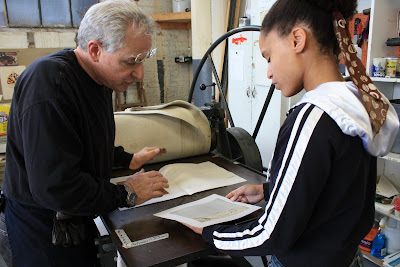As part of my research on printmaking, I visit artists working in the studio setting and ask them about their materials, methods, and practices. Some of these artists are participating in the
Southern Graphics Council Conference: Global Implications in Chicago from March 25th to 29th. Columbia College of Chicago will be hosting the conference this year.
I went to visit Jennifer Thomas' studio in the Butcher Shop Building on West Lake Street in Chicago. Jennifer teaches graphic design at the International Academy of Design and Technology in Chicago and spends about ten hours a week in her studio. She shared her techniques for screenprinting with pulp as well as inaugurating the printing process on her new-old Charles Brand etching press, manufactured about the 1930s.
Screenprinting with Pulp
Jennifer will be
demonstrating screen printing with pulp at Columbia College as part of the SGC Conference. Pulp printmaking involves creating pulp from finely beaten cotton paper, adding water and special pigments to the pulp, creating an image on a silk screen, putting the screen on a sheet of handmade paper, and then using a garden sprayer to spray the pulp over the screen. The end result is a highly textured image on paper.

Putting a screen of a bird image
on handmade paper.
Photo credit: Jennifer Thomas.

Spraying liquefied and pigmented
pulp from a garden sprayer.
Photo credit: Jennifer Thomas

Removing the screen and
inspecting the image.
Photo credit: Jennifer Thomas.

Samples of experimental images
using different sprayers.

Jennifer Thomas. 2009.
She longed to travel.He should never have let go. Screenprinted
pulp and letter press on handmade paper.
Photo credit: Jennifer Thomas.
Etching and Chine Collé
Jennifer said she bought her press on eBay and on the day I was visiting, she planned to use her etching press for the first time using her etched image of a trailer on a zinc plate. Etching usually involves using an acid or chemical to "etch" or cut into the unprotected parts of a metal surface. In chine collé, usually Japanese paper or light paper is bonded to a heavier paper in the printing process.

Etching of
Trailer #10 on a zinc plate by
Jennifer Thomas. She put a ground (for protection)
on the plate, drew the image with a metal tool, put
the plate in an acid bath (to cut the image into
the plate), removed the plate, and removed the ground.

Inking the plate with black etching ink

Using a tarlatan (stiff fabric) to wipe off ink.
The ink goes into the lines of the drawing.

She put the plate image side up, put paper on top
of the plate, and hand cranked the press to send
everything through the press.

Plate (top) and first print (below)

For the chine collé process, she first cuts Japanese
kozo paper for areas she wants to add color to
on the print. She uses the plate as a model.

Spraying the kozo paper with water and later
adding methylcellulose as a glue

The pre-pasted kozo paper is laid
glue side up on the plate. The
printed image is put on top of
the plate and everything is sent
through the press. Plate (top),
print (middle), and chine collé.

Jennifer Thomas. 2008.
Trailer #3.
Etching with aquatint and chine collé.
Fun and Games
Jennifer will be discussing and playing with her board game / artist's book
I Do (I Don't) at the SGC Conference on Saturday, March 28th.

Jennifer Thomas. 2008.
I Do (I Don't).
Handmade paper and letterpress
printing. Photo credit: Jennifer Thomas.

Jennifer Thomas. 2008.
I Do (I Don't).
Open game board. Handmade paper
and letterpress printing.
Photo credit: Jennifer Thomas.

Jennifer Thomas. 2008.
I Do (I Don't), detail.
Handmade paper and letterpress
printing. Photo credit: Jennifer Thomas.
For more information on Jennifer Thomas and her art, go to
Veronica Press on http://www.etsy.com.
Photo Credit: All photos by Amy A. Rudberg unless otherwise indicated.

























,40x40,soft+ground.2000.jpg)




,40x60,color+etching,aquatint.2003.jpg)































